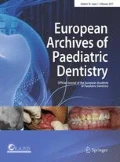Abstract
Purpose
The purpose of the study was to determine the prevalence and presentation patterns of molar incisor hypomineralisation (MIH) and hypomineralised second primary molars (HSPM) in the Division of Paediatric Dentistry at The Hospital for Sick Children (SickKids) in Toronto, Canada.
Methods
A cross-sectional study of 429 eligible participants was carried out by nine trained and calibrated examiners. The European Academy of Paediatric Dentists (EAPD) criteria for diagnosis and documentation of MIH and HSPM defects were used.
Results
Molar incisor hypomineralisation and HSPM prevalence was 12.4% and 5.2%, respectively. Regarding MIH, the affected molars and incisors attributed to 5.6% of the total prevalence, the remaining having only molars affected. Demarcated white opacities were most common in MIH (60%) and HSPM (67%), followed by yellow/brown opacities (MIH 22%, HSPM 9%), post-eruptive breakdown (MIH 8%, HSPM 24%), atypical caries (MIH 6%, HSPM 0%), and atypical restorations (MIH 4%, HSPM 0%). In both MIH and HSPM, single surface hypomineralised lesions were significantly more common than multi-surface lesions (p < 0.0001). Most lesions affected buccal enamel (MIH 55%, HSPM 47%). Lesion extension was most frequently less than 1/3 of a tooth surface (MIH 58%, HSPM 67%) and this was significantly more common in teeth affected by HSPM than MIH (p = 0.03). Individuals with HSPM were more likely to present with two affected molars than individuals with MIH (p = 0.03). Hypomineralised second primary molars were not predictive for MIH.
Conclusions
The prevalence of MIH and HSPM was within the range of published studies. The most common MIH and HSPM lesions affected single surface of a tooth, mostly on the buccal surface and were less than 1/3 of the surface area size.





Similar content being viewed by others
References
Andrade NS, Pontes AS, de Sousa Paz HE, de Moura MS, Moura LF, Lima MD. Molar incisor hypomineralisation in HIV-infected children and adolescents. Spec Care Dentist. 2017;37(1):28–37.
Elfrink ME, Ghanim A, Manton DJ, Weerheijm KL. Standardised studies on molar incisor hypomineralisation (MIH) and hypomineralised second primary molars (HSPM): a need. Eur Arch Paediatric Dent. 2015;16(3):247–55.
Elfrink ME, Ghanim A, Manton DJ, Weerheijm KL. Letter to the editor (EAPD). Eur Arch Paediatric Dent. 2016;17(2):143.
Elfrink ME, Schuller AA, Weerheijm KL, Veerkamp JS. Hypomineralised second primary molars: prevalence data in Dutch 5-year-olds. Caries Res. 2008;42(4):282–5.
Ghanim A, Elfrink M, Weerheijm K, Marino R, Manton D. A practical method for use in epidemiological studies on enamel hypomineralisation. Eur Arch Paediatric Dent. 2015;16(3):235–46.
Ghanim A, Morgan M, Marino R, Bailey D, Manton D. Molar-incisor hypomineralisation: prevalence and defect characteristics in Iraqi children. Int J Paediatric Dent. 2011;21(6):413–21.
Landis JR, Koch GG. The measurement of observer agreement for categorical data. Biometrics. 1977;33(1):159–74.
Lygidakis NA, Dimou G, Briseniou E. Molar-incisor-hypomineralisation (MIH). Retrospective clinical study in Greek children. I. Prevalence and defect characteristics. Eur Arch Paediatric Dent. 2008;9(4):200–6.
Lygidakis NA, Wong F, Jalevik B, Vierrou AM, Alaluusua S, Espelid I. Best Clinical Practice Guidance for clinicians dealing with children presenting with Molar-Incisor-Hypomineralisation (MIH): an EAPD Policy Document. Eur Arch Paediatric Dent. 2010;11(2):75–81.
Mittal NP, Goyal A, Gauba K, Kapur A. Molar incisor hypomineralisation: prevalence and clinical presentation in school children of the northern region of India. Eur Arch Paediatric Dent. 2014;15(1):11–8.
Negre-Barber A, Montiel-Company JM, Boronat-Catala M, Catala-Pizarro M, Almerich-Silla JM. Hypomineralised second primary molars as predictor of molar incisor hypomineralisation. Sci Rep. 2016;6:31929.
Petrou MA, Giraki M, Bissar AR, Wempe C, Schafer M, Schiffner U, et al. Severity of MIH findings at tooth surface level among German school children. Eur Arch Paediatric Dent. 2015;16(3):271–6.
Taylor GD. Molar incisor hypomineralisation. Evid-based Dent. 2017;18(1):15–6.
Vieira AR, Kup E. On the etiology of molar-incisor hypomineralisation. Caries Res. 2016;50(2):166–9.
Weerheijm K. Molar-incisor-hypomineralisation: site specific or world wide problem? Eur Arch Paediatric Dent. 2008;9(4):165.
Weerheijm K. The European academy of paediatric dentistry and molar incisor hypomineralisation. Eur Arch Paediatric Dent. 2015;16(3):233–4.
Weerheijm K. Molar incisor hypomineralisation (MIH). Eur J Paediatr Dent. 2003;4(3):114–20.
Funding
This study was funded by the Department of Dentistry, the Hospital for Sick Children.
Author information
Authors and Affiliations
Corresponding author
Ethics declarations
Conflict of interest
The authors declare that they have no conflict of interest.
Ethical approval
All procedures performed in studies involving human participants were in accordance with the ethical standards of the institutional and/or national research committee and with the 1964 Helsinki Declaration and its later amendments or comparable ethical standards.
Informed consent
Informed consent was obtained from all individual participants included in the study.
Additional information
Publisher's Note
Springer Nature remains neutral with regard to jurisdictional claims in published maps and institutional affiliations.
Rights and permissions
About this article
Cite this article
Sidhu, N., Wang, Y., Barrett, E. et al. Prevalence and presentation patterns of enamel hypomineralisation (MIH and HSPM) among paediatric hospital dental patients in Toronto, Canada: a cross-sectional study. Eur Arch Paediatr Dent 21, 263–270 (2020). https://doi.org/10.1007/s40368-019-00477-x
Received:
Accepted:
Published:
Issue Date:
DOI: https://doi.org/10.1007/s40368-019-00477-x




